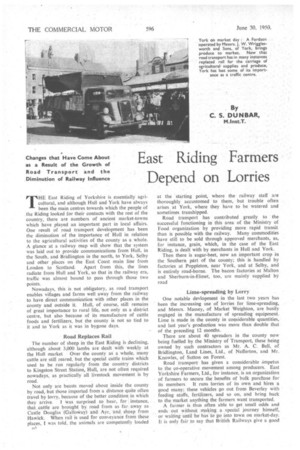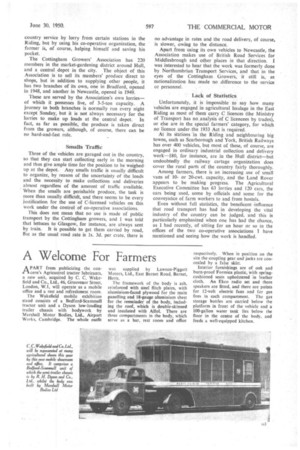East Riding Farmers Depend on Lorries
Page 60

Page 61

If you've noticed an error in this article please click here to report it so we can fix it.
By C. S. DUNBAR,
M.Inst.T.
THE East Riding of Yorkshire is .essentially agricultural, and although Hull and York have always been the main centres towards which the people of the Riding looked for their contacts with the rest of the country, there are numbers of ancient market-towns which have played an important part in local affairs. One result of road transport development has been the diminution of the importance of Hull in relation to the agricultural activities of the county as a whole. A glance at a railway map will show that the system was laid out to provide communications from Hull, in the South, and Bridlington in the north, to York, Selby and other places on the East Coast main line from
London to Scotland. Apart from this, the lines radiate from Hull and York, so that in the railway era, traffic was almost bound to pass through those two points.
Nowadays, this is not obligatory, as road transport enables villages and farms well away from the railway to have direct communication with other places in the county and outside it. Hull, of course, still remains of great importance to rural life, not only as a district centre, but also because of its manufacture of cattle foods and fertilizers, but the county is not so tied to it and to York as it was in bygone days.
Road Replaces Rail
The number of sheep in the East Riding is declining, although about 3,000 lambs are dealt with weekly at the Hull market Over the county as a whole, many cattle are still reared, but the special cattle trains which used to be run regularly from the country districts to Kingston Street Station, Hull, are not often required nowadays, as practically all livestock movement is by road.
Not only are beasts moved about inside the county by road, but those imported from a distance quite often travel by lorry, because of the better condition in which they arrive. I Was surprised to hear, for instance, that cattle are brought by road from as far, away as Castle Douglas (Galloway) and Ayr, and sheep from Hawick. When rail is used for conveyance from these places, I was told, the animals are competently loaded at the starting point, where the railway staff are thoroughly accustomed to them, but trouble often arises at York, where they have to be watered and sometimes transhipped.
Road transport has contributed greatly to the successful functioning in this area of the Ministry of Food organization by providing more rapid transit than is possible with the railway. Many commodities have still to be sold through approved merchants, as, for instance, grain, which, in the case of the East Riding, is dealt with by merchants in Hull and York.
Then there is sugar-beet, now an important crop in the Southern part of the county; this is handled by factories at Poppleton, near York, and at Selby, and is entirely road-borne. The bacon factories at Malton and Sherburn-in-Elmet, too, are mainly supplied by road
Lime-spreading by Lorry
One notable devlopment in the last two years has been the increasing use of lorries for lime-spreading, and Messrs. Massey, of Market Weighton, are busily engaged in the manufacture of spreading equipment. Lime is made in the county in considerable quantities, and last year's production was more than double that of the preceding 12 months.
There are about 40 spreaders in the county now being fuelled by the Ministry of Transport, these being owned by such contractors as Mr. A. C. Bell, of Bridlington, Land Lines, Ltd., of Nafferton, and Mr. Knowles, of Sutton on Forest.
Road transport has given a considerable Ampetus to the co-operative movement among producers. East Yorkshire Farmers, Ltd., for instance, is an organization of farmers to secure the benefits of bulk purchase for its members It runs lorries of its own and hires a good many; these vehicles go out from Beverley with feeding stuffs, fertilizers, and so on, and bring back to the market anything the farmers want transported.
A farmer is thus often able to get small odds and ends out without making a special journey himself, or waiting until he has to go into town on market-day. It is only fair to say that British Railways give a good country service by lorry from certain stations in the Riding, but by using his co-operative organization, the farmer is, of course, helping himself and saving his pocket.
The Cottingham Growers' Association has 220 members in the market-gardening district around Hull, and a central depot in the city. The object of this Association is to sell its members' produce direct to shops, but in addition to supplying other people, it has two branches of its own, one in Bradford, opened in 1948, and another in Newcastle, opened in 1949.
These are served by the Association's own lorries— of which it possesses five, of 3-5-ton capacity. A journey to both branches is normally run every night except Sunday, but it is not always necessary for the lorries to make up loads at the central depot. In fact, as far as possible, the produce is taken direct from the growers, although, of course, there can be no hard-and-fast rule.
Smalls Traffic
Three of the vehicles are garaged out in the country, so that they can start collecting early in the morning and thus give ample time for the position to be weighedup at the depot.. Any smalls traffic is usually difficult to organize, by reason of the uncertainty of the loads and the necessity to make collections and deliveries almost regardless of the amount of traffic available. When the smalls are perishable produce, the task is more than usually difficult, and there seems to be every justification for the use of C-licensed vehicles on this work under the control of co-operative associations.
This does not mean that no use is made of public transport by the Cottingham growers, and 1 was told that lettuces to Glasgow, for instance, are always sent by train. It is possible to get them carried by road, Win as the usual road rate is is. 3d. per crate, there is no advantage in rates and the road delivery, of course, is slower, owing to the distance.
Apart from using its own vehicles to Newcastle, the Association makes use of British Road Services for Middlesbrough and other places in that direction. I was interested to hear that the work was formerly done by Northumbrian Transport Services, and that in the eyes of the Cottingham Growers, it still is, as nationalization has made no difference to the service or personnel.
Lack of Statistics Unfortunately, it is impossible to say how many vehicles are engaged in agricultural haulage in the East Riding as most of them carry C licences (the Ministry of Transport has no. analysis of C licencees by trades), or else are in the special farmers' category, for which no licence under.the 1933 Act is required.
At its stations in the Riding and neighbouring big towns, such as Scarborough and York, British Railways has over 400 vehicles, but most of these, of course, are engaged in ordinary industrial collection and delivery work-180, for instance, are in the Hull district—but undoubtedly the railway cartage organization does cover the rural parts of the country fairly thoroughly.
Among farmers, there is an increasing use of small vans of 10or 20-cwt. capacity, and the Land Rover appears to be making progress. The Agricultural Executive Committee has 63 lorries and 120 cars, the cars being used, some by officials and some for the conveyance of farm workers to and from hostels.
Even without full statistics, the beneficent -influence that road transport has had in developing the vital industry of the country can be judged, and this is particularly emphasized when one has had the chance, as I had recently, of sitting for an hour or so in the offices of the two co-operative associations I have mentioned and seeing how the work is handled.




























































































































